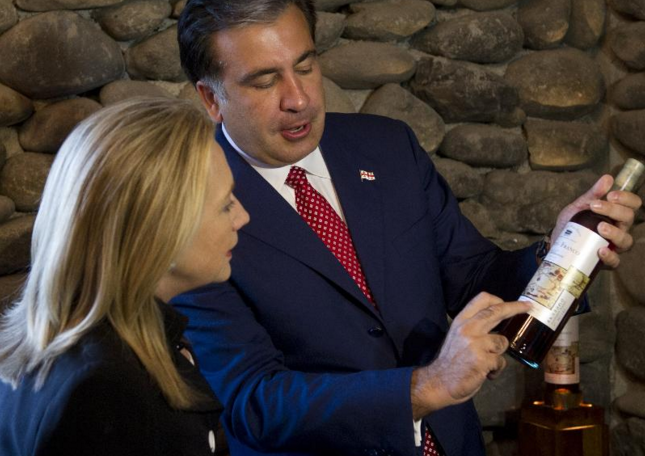作者: 发布时间:2016-11-07 关注度:127

The leading U.S. business magazine Forbes published a small article focusing on Georgian wine.
美国权威的商业杂志《福布斯》发表了一篇聚焦格鲁吉亚葡萄酒的短文。
The piece "'Ancient' Winemakers Georgia And Lebanon Grow Exports Into China's Thirsty Market" is by Jeannie Cho Lee MW, who is the first Asian Master of Wine.
这篇题为《中国葡萄酒市场如饥似渴,“古老酿酒世界”格鲁吉亚和黎巴嫩出口攀升》是由亚洲第一位葡萄酒大师李志延(Jeannie Cho Lee)撰写。
The article is illustrated by photo of ex-president Mikheil Saakashvili with current U.S. presidential candidate Hillary Clinton.
文中配有格鲁吉亚前总统米哈伊尔·萨卡什维利(Mikheil Saakashvili)与当前美国总统候选人希拉里·克林顿(Hillary Clinton)的合影。
Almost the whole of the article is devoted to Georgian wines:
"When Hugh Johnson, the inimitable British wine writer, coined the terms “old world” and “new world” to refer to wines from traditional European regions versus former European colonies, he left out the birthplace of wine: the ancient world. How else should we classify wine producing countries like Georgia, Lebanon, Armenia and Israel that are a few thousand years older than the “old world”?
文章通篇关注格鲁吉亚葡萄酒:
“英国葡萄酒作家休·约翰逊(Hugh Johnson)独辟蹊径地创造了“旧世界”和“新世界”两个词汇,借以区分传统欧洲产区与前欧洲殖民地之间的不同。只可惜他忽略了葡萄酒的发源地——古老的酿酒世界。那么我们又该如何定义格鲁吉亚、黎巴嫩、亚美尼亚和以色列等比“旧世界”还要悠久千年的酿酒国家呢?
Georgia boasts itself as the “cradle of wine civilization” with winemaking culture going back over 6,000 years, several thousand years before the first vines were cultivated in Bordeaux, Tuscany or Rioja. The wines from Georgia were favorites of the former Soviet Union’s power elite because of the quality and history of the wines, especially from the region of Kakheti. But a ban on Georgian wines by Russia from 2006 until 2013 meant the industry was forced to look for alternative export markets.
格鲁吉亚自诩为“葡萄酒文明的发源地”,拥有6000年以上的酿酒文化,比最先栽培葡萄藤的波尔多、托斯卡纳或里奥哈还要早上几千年。格鲁吉亚(尤其是卡赫基产区)葡萄酒因其上乘的品质和深厚的历史底蕴,而深受前苏联权力精英的喜爱。只不过,俄罗斯于2006至2013年的一纸禁令,格鲁吉亚葡萄酒不得不另寻他途,开辟新的出口市场。
As a result, Georgian wines have made substantial inroads into China – the Georgian agriculture minister said a free trade agreement to be signed in December this year will be hugely beneficial for both the Chinese and Georgian wine industries. According to China Daily, Levan Davitashvili, Georgia’s Minister of Agriculture, said 5 million bottles of Georgian wine were exported to China in 2015. They are likely expecting that number to double in a few years after the free trade agreement comes into effect.
日前,格鲁吉亚葡萄酒在中国市场取得了实质性的进展。格鲁吉亚农业部长表示,今年12月签署的自由贸易协定对于中国和格鲁吉亚葡萄酒产业均是重大利好。据《中国日报》报道,格鲁吉亚农业部长Levan Davitashvili介绍,2015年,格鲁吉亚葡萄酒中国出口量达500万瓶。据其估计,自由贸易协定生效后几年内,该数字将会翻番。
While Kakheti, Racha-Lechkhumi and Kverno Svaneti are difficult Georgian regional names to remember, the full bodied, gutsy red wines from the Saperavi variety blends are finding a market in China. I recently tasted over twenty Georgian wines and was very impressed with the red wines. Some were modern and juicy with a touch of savory herbs in wines like Teliani Valley’s 2013 Cabernet Sauvignon and Saperavi blend. While others were more earthy and tannic, made in the traditional style."
虽然消费者记不住拗口的格鲁吉亚地名“卡赫基”、“拉恰-列且呼米”和“Kverno Svaneti”,但是酒体饱满、果味浓郁的萨别拉维混酿红葡萄酒却在中国市场赢得了一席之地。我最近品尝了二十余款格鲁吉亚葡萄酒,对它的红葡萄酒印象非常深刻。有些葡萄酒契合时尚潮流,滋味醇厚并带着淡淡的草本芬芳,比如蒂里阿尼山谷2013年赤霞珠和萨别拉维混酿葡萄酒。另外,传统工艺酿造的葡萄酒透着泥土气息、单宁突出,更显朴实无华与独特韵味。
In the last paragraph the author briefly mentions the wines from Lebanon: "Another ancient wine region that has captured the hearts of wine lovers since the 1980s is Chateau Musar from Lebanon".
文章结尾,作者还提及黎巴嫩葡萄酒,称其为:“自上世纪八十年代以来,另一个古老产区掳获了葡萄酒爱好者的心,它就是来自黎巴嫩的穆萨酒庄 (Chateau Musar)。”








